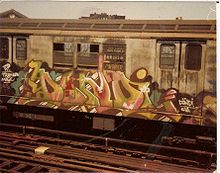- DONDI
-
- This article is about the graffiti artist. For the comic strip, see Dondi.
Donald Joseph White, "DONDI" (April 7, 1961 – October 2, 1998) is considered one of the most influential graffiti artists in the history of the movement.
Contents
Biography
Early life
Born in the East New York section of Brooklyn, Dondi was the youngest of five children. He was of African American and Italian American descent. He attended a catholic school during his junior years. By the 1970s East New York became an unstable region with racial tensions social conflicts such as the prominence of street gangs. In an interview with Zephyr, Dondi stated that he had joined several gangs in the 1970s to avoid being attacked. Anxious to leave high school behind, he earned his GED in 1980, took a job in a government office, and began to indulge his interest in graffiti.
Graffiti
Graffiti became a serious part of Dondi's life in the mid 1970s. He tagged using “NACO” and “DONDI”, and worked on refining his style, gradually moving from simple tagging to building more elaborate pieces. Using the name Dondi (a version of his own name) was considered very risky at the time, as the Metropolitan Transit Authority and the New York police were trying to crack down on writers. In 1979, Dondi officially adopted his name when he painted a giant piece on the roof of his house.
He became a member of TOP crew (The Odd Partners) in 1977. In 1978, Dondi formed his own crew, named CIA (Crazy Inside Artists), which included other prominent artists such as his good friend DURO, CRASH, DOC and RASTA. For the next 20-odd years, Dondi became recognized as the stylistic standard, influencing a generation of graffiti writers.[1]
Dondi pioneered many of the styles and techniques still used by modern graffiti artists. Though he would often do wildstyle pieces for the benefit of other writers (like the famous 2MANY piece), he wanted the public to be able to read and enjoy his work, so he would focus on readable letters with intricate fills and characters.
His most famous work was Children of the Grave Parts 1, 2 and 3—three whole cars on the New York subway in the years 1978–1980. The name of the piece was taken from a Black Sabbath song. Journalist Martha Cooper filmed the final piece from start to finish. On this last piece, Dondi adopted the cartoon characters from the late Vaughn Bode. It was a dream-come-true for Dondi, who was building his reputation as a graffiti writer. He later painted a version of "Children of the Grave 3" in a studio.
He was the first graffiti artist to have a one-man show in the Netherlands and Germany, and his work is collected by European museums.
Death
Dondi died of AIDS on October 2, 1998.
Legacy
Dondi had no children but left behind hundreds of paintings and drawings, the ownership of which is still being disputed.[citation needed] Zephyr, IZ, Doc and Keo painted tribute murals between 1998-2000. In 2007 Dondi was featured on a Converse shoe as part of the Product Red project.[2]
The glass-pipe artist Marbleslinger features a Dondi stencil on a series of pieces from 2008.
Media
Exhibitions and appearances
- Martha Cooper and the Radiant Children (1979)
- Esses Studio (1980)
- New York/New Wave (1981)
- Fun Gallery (1982)
- New York City Rap Tour (1982)
- Yaki Kornblit Gallery (1983)
- Fun Gallery (2) (1983)
- Museum Boymans - Van Beunigen (1983)
- European Museum Shows (1983–85)
- 56 Bleecker Gallery (1987)
- The Rempire Show (1992)
- Groninger Museum Retrospective (1992)
Film
- Dreams Don't Die (1982)
- Style Wars (1983)
- Wild Style (1983)
Further reading
- Andrew Witten and Michael White, Dondi White Style Master General: The Life of Graffiti Artist Dondi White, New York: Regan/HarperCollins Books, 2001. ISBN 0060394277 - see ZEPHYR
Notes
- ^ Zephyr, "Obituary and Biography" October 8, 1998, retrieved November 12, 2006.
- ^ Sneakerfreaker.com
External links
Street art Culture Activism · Aerosol paint · Culture jamming · Direct action · Graffiti (terminology · use theory) · Guerrilla art · Hip hop culture · Installation art · Kolam · Murals · Propaganda · Reverse graffiti · Screenprinting · Spray paint art · Stencil graffiti · Sticker art · Subway Art · Yarn bombing
Lists of artists Companies Related articles Categories:- 1961 births
- 1998 deaths
- American graffiti artists
- African-American people
- American people of Italian descent
Wikimedia Foundation. 2010.

